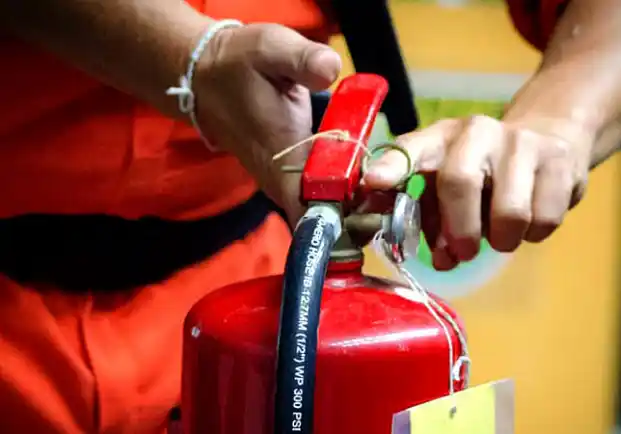Fire Extinguisher Shelf Life and the Importance of Regular Inspection

Fire extinguishers should be available everywhere to ensure public safety and protect lives and property. They are the first line of defense in various incidents and emergencies: they help control fires in their early stages and prevent them from spreading widely. But have you ever wondered about the service life of a fire extinguisher and how to check it in order to replace the extinguisher on time?
In this article, we’ll explain that lifetime, how to determine it, and when you should replace your fire extinguisher.
Importance of periodic inspection of fire extinguishers
Before learning the service life of a fire extinguisher, it’s important to understand the value of periodic inspection, which includes:
- Checking the extinguisher and confirming the pressure gauge is in the correct zone ensures the unit is immediately ready for emergencies.
- Routine maintenance enables early detection of corrosion or damage to the valve, cylinder, or any component—allowing corrective action before the problem grows.
- Regular inspection helps extend the extinguisher’s lifespan, reducing the need for frequent replacements.
Learn more: Fire-fighting equipment
When should a fire extinguisher be replaced?
Certain signs indicate the extinguisher’s service life has ended and replacement is necessary, including:
- Visible damage such as corrosion, cracks, or rust—anything that could affect performance and safety.
- Low pressure below the recommended level, indicating loss or leakage of the extinguishing agent.
- Exceeding the manufacturer’s recommended service life, which may reduce effectiveness.
- Any prior discharge; an extinguisher should be replaced or professionally recharged after use—even if only partially discharged.
What is the service life of a fire extinguisher?
The service life depends on several factors, but in general you can find it on the label or stamping on the extinguisher body—typically between 5 and 10 years.
Approximate lifetimes by type:
- Dry chemical (powder): usually 5–8 years.
- CO₂: often 3–5 years.
- Water: up to 5 years.
Where do I find the expiration date?
All types of fire extinguishers, regardless of manufacturer, have markings that indicate expiration and production dates—either stamped into the cylinder or printed on a label.
Factors affecting a fire extinguisher’s service life
A number of factors influence an extinguisher’s lifespan, including:
- Extinguisher type: service life varies with type, specifications, and design.
- Manufacture date: materials can degrade over time, affecting performance.
- Routine maintenance: identifying and fixing issues early helps preserve the extinguisher’s service life.
- Environmental conditions: high temperatures and similar factors shorten service life; therefore, store the unit in a suitable, protected environment.
How to maintain and inspect a fire extinguisher
Below are the main steps for maintaining and inspecting extinguishers to ensure they’re in good condition:
1) Visual inspection
Perform a visual check monthly by:
- Ensuring easy access with no obstructions.
- Checking the outer cylinder for cracks or rust.
- Verifying the pressure gauge is in the operable range so the unit is ready when needed.
- Inspecting the nozzle and hose to confirm readiness and absence of damage.
- Inverting (gently turning upside down) to loosen any compacted agent.
- Confirming the label is legible and facing outward when mounted.
2) Annual check
An annual inspection commonly referred to as a hydrostatic test is essential for safety and effectiveness. CO₂, water, and wet-chemical extinguishers can be hydrostatically tested every 5 years, while dry-chemical units are tested every 12 years.
This verifies the cylinder can withstand rated pressure and has no structural weakness or leaks. Always use trusted maintenance providers.
When should a fire extinguisher be replaced?
Key considerations to help you decide when replacement is due:
Service life period
Knowing the unit’s service life helps you plan timely replacement or re-certification.
Local guidance
Local authorities set renewal dates and inspection intervals according to regulations.
Storage conditions
Consider storage conditions; repeated use or high temperatures may necessitate earlier replacement.
Routine maintenance
Regular inspection and servicing confirm condition; replace without delay if any damage is found.
Infrequent use
Long periods without use can lead to case degradation or a leaking nozzle.
Low pressure
A gauge reading below the recommended zone indicates loss or leakage of agent.
Which companies are best for periodic extinguisher maintenance?
- Periodic maintenance is essential to ensure readiness when needed. Al-Safi Company is a leading security and safety provider in Saudi Arabia, combining over 40 years of experience with strict adherence to Civil Defense standards.
- The company offers inspection, recharging, and maintenance services to ensure long-term performance and effectiveness in emergencies—protecting places from the negative effects of fire and safeguarding lives and property.
- If you want periodic maintenance or a replacement for your extinguisher, Al-Safi is your ideal choice. Don’t hesitate to call us now.
In conclusion, you now know how to determine a fire extinguisher’s service life and when to replace it. Every home and workplace should have extinguishers to protect lives and property. Knowing the service life allows timely replacement and helps keep you safe in emergencies.
Frequently asked questions about extinguisher service life
How do I find the expiration date?
It’s usually printed or stamped on the outside of the cylinder.
What’s the typical lifetime?
The average expected lifetime is about 5 to 10 years.
How do I know an extinguisher is no longer usable?
You can tell an extinguisher is at end of life if you see:
An expired date on the label.
A pressure gauge in the red zone.
Visible rust or external damage.
A broken or missing tamper seal.



